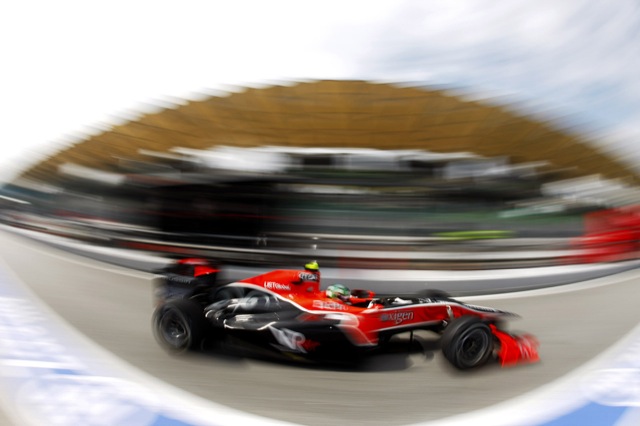Formula One has been going through a phase of attempting to cut costs recently, the introduction of various rules controlling the amount of staff allowed at races, the amount of spare parts and the use of components within the cars all helping to shed some fat from the running costs and enable the entry barriers for new teams to be lowered. However, one rule that is due to come into force for 2009 actually adds considerable cost to some teams, so much in fact, they are currently in serious financial trouble.
Super Aguri today announced that a deal that would have seen the team sold to a Middle Eastern company has fallen through, sending waves of doubt through the Formula One community and potentially resulting in the Japanese squad having to stay at home on the weekend of the Spanish Grand Prix.
Also facing questionable status, although not just yet, is Red Bull’s second team, Scuderia Toro Rosso. Company owner Dietrich Mateschitz has said that the team is going up for sale after the 2008 season is complete, principally because he doesn’t want his company to pay out the extra funds required to design and build their own car.
So, why are the FIA insisting that the formula returns to a traditional constructor series, as opposed to teams buying chassis from other squads? It’s mainly to keep the peace. Williams have been very outspoken over the whole affair and have threatened to take chassis-buyers to court over the matter. And to a degree, you have to understand Williams’s point. The privateer team who have been struggling financially in the past few years (comparably, anyway) still build their own car, pushing the boundaries and innovating new ideas.
But the flip side of the argument, and the point of this post, is that Formula One could end up facing an eighteen car grid next year. Losing Super Aguri and STR would be a very low point for the sport, especially after Dave Richards’ Prodrive entry went to the dogs in early 2008. Fewer teams would mean fewer fans, less competition on the track and no point in me owning a Super Aguri t-shirt.
As far as I’m concerned, Formula One activated the self-destruct sequence when they ruled that customer chassis would no longer be allowed. In an ideal world, every team would have their own, uniquely designed car. But this isn’t the ideal world, and the FIA have failed to appreciate that.
As I said in the title, Formula One’s self destruct sequence has been initiated.




















I agree with the post. It’s a sequence of attitudes that will end on the total destruction o f-1. Buillding a car and putting it on track is not an usual or cheap business… And with all these barriers, it’s going to be just impossible.
In the end, we may have a F1 of big companies, like Mercedes, Toyota and Honda… and not even them are very excited with the idea of competing in F1…
The other major risk for F1 in customer cars is that as two or three teams dominate, we will see increasing numbers of teams becoming BMW, McLaren or Ferrari customers, and we may, in a few years time, end up having just two or three (or even one) chassis on the grid.
It was clear that Prodrive were going to take a rebadged McLaren, so would come from nowhere to the front of the grid on the smallest budget. Which other team could compete with this? If any of the other teams wanted to maximise their exposure they would be forced to follow suit.
We could end up seeing a Ferrari v McLaren (albeit in different liveries) battle every week involving 10 of one and 12 of another. I’m not convinced this is what I or a lot of F1 fans would want.
I think you’re being a wee bit pessimistic about the situation, Ollie. As it is, many fans don’t want to see what could happen if customer cars were allowed: we’d basically have an A-division and a B-division.
Perhaps the FIA should’ve allowed new teams to use customer cars, but only for the first 1 or 2 seasons of existence, but would then have to build their own car afterwards.
But I’m confident solutions will be found, probably for Super Aguri (Honda would not want to be seen as the one who shut down the all-Japanese team, thus incurring huge negative PR) and certainly for Toro Rosso (Berger is aggressively looking for a new partner investor)
well, the concorde agreement allegedly states 20 cars as a limit. if there are less than 10 teams, some may have to run 3 cars. this was actually on cards towards the end of 2004 season when Ford left F1 leaving Jaguar in limbo and Jordan + Minardi without engines for 2005… different issue is that the concorde agreement has expired already but it looks like the F1 still runs according to it …
If we have teams willing to supply 2 cars to junior teams, then there would sure be teams willing to run 3 cars … nobody would have to pretend anything and paint the same cars with different livery …
I would say that both Toro Rosso and Super Aguri would now be much easier to sell if Toro Rosso have continued to build-on on their own Minardi chassis or Super Aguri kept working on their old Arrows car … They would both be backmarkers for sure, but there would be something the new owners could base their development on. Whoever buys them now has to start from scratch … Look at Jordan/Midland/Spyker/Force India for comparison …
but then again, there is this grey area – if STR and SA are to become full constructors, will they have to start building new cars from zero, or will they be allowed to keep their 2008 cars as a foundation of their new own cars ?
I believe, since the IP is already transferred to a third party and nobody is claiming that it was stolen, that the 2008 cars could be used for a base for both teams rather than needing to start from scratch – as long as some modifications were made to justify calling the IP separate. There’s no rule against IP transfer, only against two teams using the same IP.
[…] When I first mentioned those two words, self destruct, back in April, some thought I was being too pessimistic. And although the situation was different (it related to customer chassis), the over-riding feeling was that of the governance of the sport not being shrewd enough to look beyond the end of their nose, let alone a few months into the future. […]